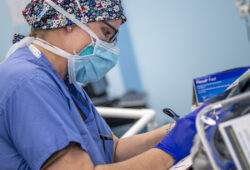AAOS 2021 key topics
Key takeaways from the American Association of Orthopaedic Surgeons (AAOS) conference in September 2021
 The Annual Meeting of AAOS provided insight into many of the current topics in orthopaedic surgery. One specifically of interest to care providers is the opioid epidemic.
The Annual Meeting of AAOS provided insight into many of the current topics in orthopaedic surgery. One specifically of interest to care providers is the opioid epidemic.
Impactful statistics, research and recommendations on the opioid epidemic and pain management were also presented at the AAOS Annual Meeting. One presenter reported that 12 million U.S. adults misused a prescription pain reliever in 2016, with 35% of the opioids prescribed by a practitioner, 53% obtained from a family member and only 6% from a drug dealer.
The nature of the diseases and injuries that orthopaedic surgeons treat places orthopaedic care at the front line of the fight against the opioid epidemic. In total joint surgery alone, it was noted that 10% of patients who were opioid-naive before surgery were still using them regularly at six months post-surgery. A recent survey conducted by Western Orthopaedic Association reported that 75% of orthopaedic surgeons agree there is an opioid epidemic. Orthopaedic surgeons are taking the battle seriously, and the recent AAOS meeting provided several educational offerings on pain management and guidance on how to reduce opioid use.
Overall, orthopaedic surgeons have responded by researching optimal quantities and refills to maintain satisfaction and reduce diversion. This approach leaves behind concern for the impact of prescribing opioids on patient satisfaction, as studies do not support this apprehension. Multimodal pain programs have become a gold standard, and institutional opioid prescribing guidelines and retrieval programs are essential. Pursuits of non-narcotic pain management such as meditation, mindfulness, nerve stimulation and cold therapy, to name a few, are encouraged.
At the time of this writing, Karen Bush, MSN, FNP, BC, NCRP, was a HealthTrust Director, Clinical Research & Education.
Share Email AAOS, Clinical Connections, Industry Updates




